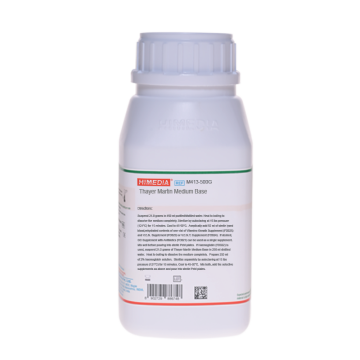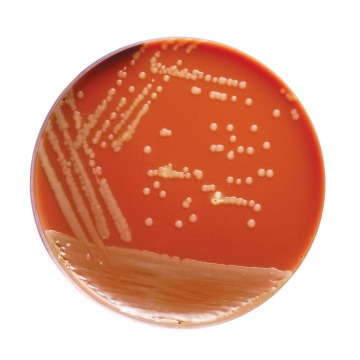 Your enquiry has been submitted
Your enquiry has been submitted
NYC Agar Base
Intended Use
Recommended for selective isolation of Gonococci.
Composition**
| Ingredients | g/L |
|---|---|
| Proteose peptone | 15.000 |
| Corn starch | 1.000 |
| Dextrose (Glucose) | 5.000 |
| Sodium chloride | 5.000 |
| Dipotassium hydrogen phosphate | 4.000 |
| Potassium dihydrogen phosphate | 1.000 |
| Agar | 20.000 |
Final pH (at 25°C): 7.4±0.2
**Formula adjusted, standardized to suit performance parameters
Directions
Suspend 25.50 grams in 320 ml purified/distilled water. Heat to boiling to dissolve the medium completely. Sterilize by autoclaving at 15 lbs pressure (121°C) for 15 minutes. Avoid overheating. Cool to 45-50°C and add aseptically 100 ml of sedimented horse blood cells and 60 ml of citrated horse plasma along with rehydrated contents of one vial of NYC Supplement (FD150) and one vial of Yeast Autolysate Supplement (FD027). Mix well and pour into sterile Petri plates.
Principle And Interpretation
NYC Agar Base was originally developed by Fauer, Weisburd and Wilson (1-3) at the New York City Department of Health for selective isolation of pathogenic Neisseria species from clinical specimens. It consists of primarily a peptone-corn starch-agar-base buffered with phosphates and supplemented with horse plasma, horse haemoglobin, dextrose, yeast autolysate and antibiotics (1,2). This medium is superior to other media generally employed for the isolation of Neisseria species (1,4,5). The transparent nature of the medium helps in studying the colonial types (6).
Proteose peptone, horse plasma, haemoglobin provide nutrients for the growth of N. gonorrhoeae and N. meningitidis. Phosphate buffers the medium. The selective supplement added contains the antibiotics vancomycin, colistin, nystatin and trimethoprim, to suppress the accompanying flora. Vancomycin is inhibitory for gram-positive bacteria. Colistin inhibits gram-negative bacteria, including Pseudomonas species, while Proteus is inhibited by trimethoprim (7). The combination of trimethoprim and colistin acts synergistically against gram-negative bacilli (8). Starch neutralizes the toxic metabolites produced by Neisseria. The yeast autolysate supplement fulfils the CO2 requirements needed to enhance Neisseria growth. Yeast contains oxaloacetic acid which is metabolized by gonococci to produce sufficient CO2 for growth of capnophilic gonococci (9). Also, presence of yeast autolysate reduces the lag phase of growth of Neisseria, thus enhancing both size and number of colonies. The specimen can be directly streaked on the medium to obtain maximum isolation.
Type of specimen
Clinical samples: Throat swabs, vaginal secretions, rectum and urethra swabs
Specimen Collection and Handling
For clinical samples follow appropriate techniques for handling specimens as per established guidelines (10,11).
After use, contaminated materials must be sterilized by autoclaving before discarding.
Warning and Precautions :
In Vitro diagnostic Use only. For professional use only. Read the label before opening the container. Wear protective gloves/protective clothing/eye protection/ face protection. Follow good microbiological lab practices while handling specimens and culture. Standard precautions as per established guidelines should be followed while handling clinical specimens. Safety guidelines may be referred in individual safety data sheets.
Limitations :
- Due to nutritional variations and fastidious nature of organisms certain strains may show poor growth.
Performance and Evaluation
Performance of the medium is expected when used as per the direction on the label within expiry period when stored at the recommended temperature.
Quality Control
Appearance: Cream to yellow homogeneous free flowing powder
Gelling: Firm, comparable with 2.0% agar gel.
Colour and Clarity of Prepared medium: Yellow coloured clear to slightly opalescent gel forms in Petri plates
Reaction: Reaction of 5.1% w/v aqueous solution at 25°C. pH: 7.4±0.2
pH: 7.20-7.60
Cultural Response
Cultural characteristics observed after in presence of 5-10% CO2 and 70% humidity with added sedimented horse blood cells and citrated horse plasma along with rehydrated contents of 1 vial of NYC Supplement (FD150) and 1 vial of Yeast Autolysate Supplement (FD027), after an incubation at 35-37°C for 40-48 hours.
| Organism | Inoculum (CFU) | Growth | Recovery |
|---|---|---|---|
| Haemophilus influenzae ATCC 19418 | 50-100 | good-luxuriant | >=50% |
| Neisseria gonorrhoea ATCC 19424 | 50-100 | good-luxuriant | >=50% |
| Neisseria meningitidis ATCC 13090 | 50-100 | good-luxuriant | >=50% |
| Streptococcus pneumoniae ATCC 6303 | 50-100 | good-luxuriant | >=50% |
| Streptococcus pyogenes ATCC 19615 | 50-100 | good-luxuriant | >=50% |
| Pseudomonas aeruginosa ATCC 27853 (00025*) | 50-100 | none-poor | <=10% |
| Proteus mirabilis ATCC 13883 | 50-100 | none-poor | <=10% |
Key: *Corresponding WDCM numbers.
Storage and Shelf Life
Store between 10-30°C in a tightly closed container and the prepared medium at 2-8°C. Use before expiry date on the label. On opening, product should be properly stored dry, after tightly capping the bottle inorder to prevent lump formation due to the hygroscopic nature of the product. Improper storage of the product may lead to lump formation. Store in dry ventilated area protected from extremes of temperature and sources of ignition Seal the container tightly after use. Product performance is best if used within stated expiry period.
Disposal
User must ensure safe disposal by autoclaving and/or incineration of used or unusable preparations of this product. Follow established laboratory procedures in disposing of infectious materials and material that comes into contact with clinical sample must be decontaminated and disposed of in accordance with current laboratory techniques (10,11).
Reference
- Fauer, Weisburd, Wilson and May, 1973, Health Lab. Sci., 10: 44.
- Fauer, Weisburd and Wilson, 1973, Health Lab. Sci., 10: 55.
- Fauer Y. C., Weisburd M. H. and Wilson M. E., 1973, Health Lab Sci., 10(2), 61.
- Granato, Schneible-Smith and Weiner, 1981, J. Clin. Microbiol.13:963.
- Griffin P. J. and Reider S. V., 1957, J. Biol. Med., 29, 613.
- MacFaddin J. F., 1985, Media for Isolation-Cultivation-Identification-Maintenance of Medical Bacteria, Vol. 1, Williams and Wilkins, Baltimore
- Murray P. R., Baron J. H., Pfaller M. A., Tenover F. C. and Yolken R. H. (Eds.), 1999, Manual of Clinical Microbiology, 7th Ed., American Society for Microbiology, Washington, D.C.
- Simmons N. A., 1970, J. Clin. Pathol., 23, 757.
- Lawton and Koch, 1982, J. Clin. Microbiol., 20: 905.
- Isenberg, H.D. Clinical Microbiology Procedures Handbook 2nd Edition.
- Jorgensen, J.H., Pfaller, M.A., Carroll, K.C., Funke, G., Landry, M.L., Richter, S.S and Warnock., D.W. (2015) Manual of Clinical Microbiology, 11th Edition. Vol. 1.
| Product Name | NYC Agar Base |
|---|---|
| SKU | M1348 |
| Product Type | Regular |
| Physical Form | Powder |
| Origin | Animal |
| Packaging type | HDPE |
| References | 1. Fauer, Weisburd, Wilson and May, 1973, Health Lab. Sci., 10: 44. |
| Customized Product Available | No |








